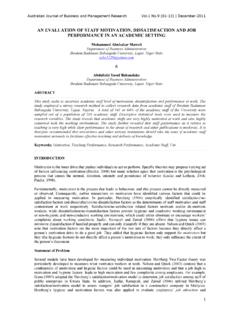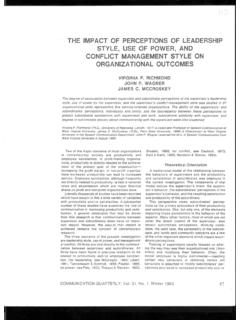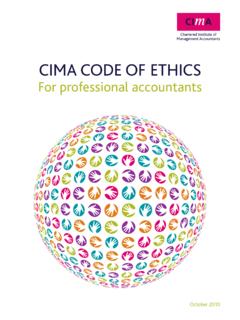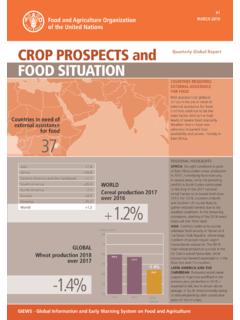Transcription of IMPACT OF CONFLICT MANAGEMENT ON CORPORATE …
1 Australian Journal of Business and MANAGEMENT Research [44-49] | August-2011. IMPACT OF CONFLICT MANAGEMENT ON CORPORATE productivity : AN. EVALUATIVE STUDY. Obasan Kehinde , A. Department of Business Administration, Olabisi Onabanjo University, Ago Iwoye. Ogun State, Nigeria. Email: ABSTRACT. A wide divergence of opinion exists on the source and effect of conflicts on CORPORATE productivity and the effectiveness of the various strategies available for managing them. It has been argued by some that conflicts are signs of a vibrant organization while others contend it is destructive and capable of retarding stability and profitability of organizations. Using a student t distribution to test the significance of response and purposive sampling technique to administer a self-design questionnaires to 50 respondents cutting across all cadres of staff of First Bank of Nigeria Plc.,(Lagos Branch), revealed that the main sources of CONFLICT in the organization relate to perception and value problems.
2 The specific issues bother on employee compensation and welfare while managers prefer the compromise, problem solving and dominating strategies to minimizing the incidence of organisational conflicts . Based on the findings of the study, it was recommended that strategies which promote industrial democracy should be chosen by MANAGEMENT as the preferred option in dispute resolution. In addition, the ideal level of CONFLICT resolution required to attain optimum performance for every organisation is unique and situational hence managers are duty bound to establish the best maintainable by the organisation. Keywords: CONFLICT , MANAGEMENT , productivity , strategy INTRODUCTION. The establishment and continuous existence of organisation through the realization of set goals and objectives requires the continuous and effective functioning of its material input with the human element being indispensable. However, the human elements required to facilitate goals attainment often engage in disagreement and variance over factors such as interest, views, style of MANAGEMENT among others.
3 The reactionary effect is due to the perceived incompatibilities resulting typically from some form of interference or opposition is term CONFLICT . Azamosa (2004) observed that conflicts involve the total range of behaviours and attitudes that is in opposition between owners/managers on the one hand and working people on the other. It is a state of disagreement over issues of substance or emotional antagonism and may arise due to anger, mistrust or personality clashes. Irrespective of the factors resulting in CONFLICT , it has been observed that industrial conflicts produce considerable effects on organisations and should be consciously managed as much as possible. For people to progress at work and other aspect of life, there must be cooperation which is essential to ensure task attainment and stability in life. However, it would be wrong to reach the conclusion that cooperation is good while CONFLICT is bad, this is because both concepts are pervasive and co-exist in our social life.
4 CONFLICT is inevitable given the wide range of goals for the different stakeholder in the organization and its absence signifies MANAGEMENT emphasizes conformity and stifles innovation. Rahim (2001) opined that CONFLICT may be interpersonal or inter group with Interpersonal conflicts occurring between a supervisor and his subordinate or between two individuals at the same level of the organizational hierarchy. Inter group conflicts often occur between two trade unions, between two departments or between MANAGEMENT and workers while attempting to implement the policies and programme of the organization Hence, this paper reviews the sources, types, causes and consequential effect of CONFLICT and its effective MANAGEMENT on CORPORATE productivity with the aim of suggesting a valid, objective and transferable conclusion to the banking industry using First Bank of Nigeria as a case study. LITERATURE REVIEW. Schramm-Nielsen (2002) defines a CONFLICT as a state of serious disagreement and argument about something perceived to be important by at least one of the parties involved while Azamosa (2004), says industrial CONFLICT involves the total range of behaviour and attitudes that is in opposition between individual owners and managers 44.
5 Australian Journal of Business and MANAGEMENT Research [44-49] | August-2011. on one hand and working people on the other. However, there are many sources of organisational conflicts as categories by Jones and George (2003) with each category having its unique characteristics. Figure the various sources of organisational conflicts Duke (1999) observed that conflicts could arise between individuals or groups in an organisation if the goals are not specified or when the MANAGEMENT shift blame on all or a unit(s) involved in work process. However, not all conflicts are bad and not all conflicts are good. People tend to view CONFLICT as a negative force operating against successful completion of group or common goals. CONFLICT can create negative IMPACT to group but may also lead to positive effects depending on the nature of the CONFLICT . The figure below adapted from Jones and George (2003) depicts the level of CONFLICT that is ideal and essential for an organisation to attain optimum performance and effective decision making.
6 Figure the relationship between performance and level of CONFLICT . Hence, MANAGEMENT are duty bound to resolve conflicts properly for the sake of increasing organisational performance because the result of such action will result to good communication, time MANAGEMENT , good cooperation and increase organisational performance. 45. Australian Journal of Business and MANAGEMENT Research [44-49] | August-2011. A good CONFLICT improves decision outcomes especially on task-related CONFLICT and group productivity by increasing the quality through a constructive criticism and individual playing a devil advocate role since most task related CONFLICT allows the exchange of ideas and assist better performance among work force. Various CONFLICT MANAGEMENT theories opined that a healthy CONFLICT MANAGEMENT system should integrate the internal sub-system with the higher level of the organisational hierarchy while Ford (2007) provides a four-way process which include assessment and inquiry, addresses the design, implementation and evaluation aimed at reaching a valid and objective CONFLICT MANAGEMENT decision.
7 Tseveendorj (2008) observed that the Malaysia bank employees rated communication, perception, values and culture problems as moderately serious sources of CONFLICT although the staff differed from the officers in their perception to the degree of seriousness of these problems while Okolo (1977) identified conditions of service, opportunity, salary and wages and job security as the leading sources of CONFLICT in Nigeria. Ekong (2000) reported a positive correlation between democratic MANAGEMENT styles and organizational stability. He noted that democratic strategies would promote inclusion in decision and by consequence workers identification with decisions and commitment to the organization. Lawrence and Lorsch (1967), indicated that a confrontation style dealing with group CONFLICT was used to a significantly degree in higher than in lower performing organizations. Korbanik, Baril and Watson, Tutzaver and Roloff (1988) and Wall and Galenes (1986) commented on the integrating style of handling CONFLICT which shows that this style results in high joint benefits for the parties.
8 While Rahim (2004) have suggested that the nature of leadership power in an organization mediates the needs of CONFLICT MANAGEMENT strategies. Thus, organisational stability may be maintained even when the leader is low in CONFLICT MANAGEMENT because workers sometimes exhibit acceptance behaviour over the superior's attitude thus reflecting apathy and subjugation with little manifestation of aggression (Gbadamosi and Adebakin,1996). Vigil-King (2000) also found that the use of more integrative CONFLICT MANAGEMENT strategies are likely to have higher commitment than teams using less integrative styles while it was noted that a supportive leader engenders respect, job satisfaction and higher productivity from his staff while or authoritarian leaders, even if productivity is higher in the short run, it is bound to fall in the long run. RESEARCH METHODOLOGY. This study employed the descriptive survey design whose purpose according to Ezeani (1998), is to collect detailed and factual information that describes an existing phenomenon.
9 The target population of the study was First Banks of Nigeria, Lagos Branch. A total enumeration sampling technique was used to select 50 personnel who provide response to a structured questionnaire design to solicit their view about the IMPACT of CONFLICT MANAGEMENT on CORPORATE productivity in Nigeria. However, a purposively 'sampling of (a) Supervisory MANAGEMENT cadre staff using departmental heads/branch managers as proxies, and (b) union officials, was made due to the nature of the issue being investigated. The questionnaire was specifically designed to accomplish the objectives of the study and was analyzed by scoring the responses. The response choice scoring weights were strongly agreed - 4 points, Agree - 3 points, Disagree - 2 points and strongly disagree- I point. The mean score and standard deviation for each group of related items were then pooled together and used to analyse the hypothesis formulated using t-test as highlighted by Owie (1991) and Igho (1999).
10 We attempt to establish a relationship between managers' CONFLICT MANAGEMENT and workers' performance. In other words, the study attempts to determine whether workers'. performance depends on the strategies adopted by managers in preventing and resolving conflicts in the organization. The basic model is thus specified as: WP =f (CMS). Where: WP= Workers performance CMS= Managers CONFLICT MANAGEMENT Strategies ANALYSIS AND RESULTS. The analysis was carried out in accordance with the research questions. In each case, the responses to questionnaire questions were scored and the mean and standard deviation determined. A mean response cut-off score ( (4+3+2+1)/4 was adopted. Responses to the various questions were obtained from the analysis of statement and the results were shown in the table below. 46. Australian Journal of Business and MANAGEMENT Research [44-49] | August-2011. S/N STATEMENTS Mean Standard deviation 1 Causes: Unacceptable terms of employment such as poor hours of work, poor salary and lack of fringe benefits 2 Poor human relations between MANAGEMENT and employees 3 Non consultation with employees before key decisions affecting them are 2.)









